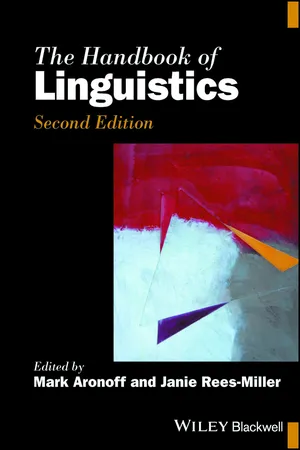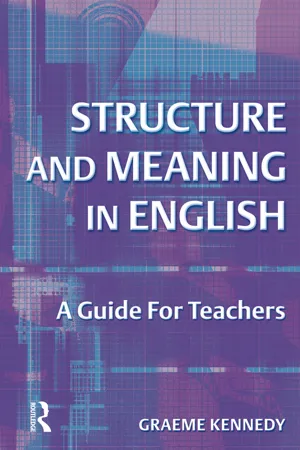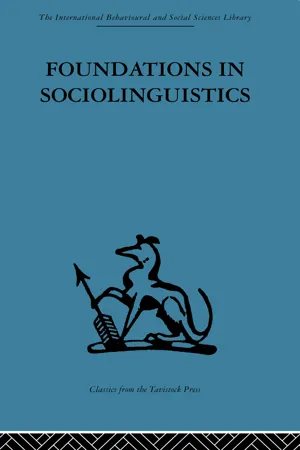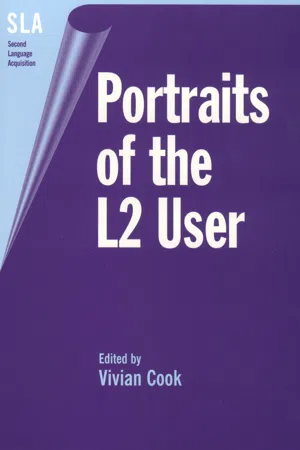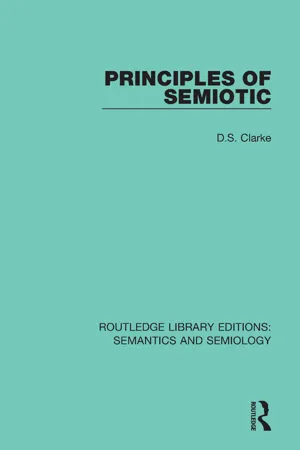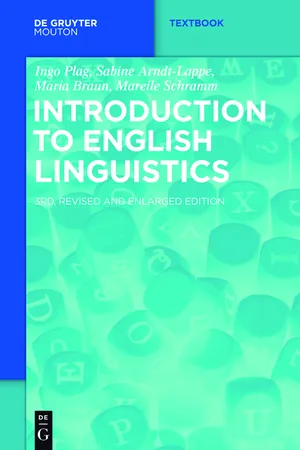Languages & Linguistics
Sentence Functions
Sentence functions refer to the different roles that sentences play in communication. These functions include declarative (making a statement), interrogative (asking a question), imperative (giving a command), and exclamatory (expressing strong emotion). Understanding sentence functions is important for analyzing the structure and meaning of language.
Written by Perlego with AI-assistance
Related key terms
9 Key excerpts on "Sentence Functions"
- eBook - ePub
Teaching English
A Linguistic Approach
- John Keen(Author)
- 2018(Publication Date)
- Routledge(Publisher)
5 Frameworks for language functionLanguage functions and social rulesEvery sentence in every language is multi-functional. Thus the English sentence, ‘John isn’t very happy’ could be used to assert an opinion, to suggest a course of action (implying, ‘So why don’t you go and talk to him?’) or to start off a conversation. But before we can start looking at functions of language we must be clear what it is in language that can have a function. If we want to say, as we shall, ‘The function of this is …’ then we cannot be talking about sentences or words. Suppose the function we had in mind were that of referring to something, and that we had in mind the word ‘John’. So ‘The function of the word “John” is to refer to John’. If in a crossword someone writes the word ‘John’ then that is just an occurrence of the word in the abstract. But if someone says, ‘John’s the one with black hair and glasses’ in the course of a conversation then ‘John’ does refer to somebody. The difference is in the use. The word itself does not refer to anything, any more than the nonsense word ‘binks’ refers to anything. But somebody could use the word ‘binks’ to refer to somebody, perhaps as a nickname or a trade name. Words themselves do not have functions; to have a function a word must be used. The same goes for sentences; ‘John is daft’ as I have just written it – as an example of an English sentence illustrating the structure ‘subject + “is” + subject complement’ – does not say anything about anybody. But it could be used to say that John is daft if somebody wanted to say that.This is an important preliminary distinction because it means that we must approach the problem by looking at particular uses of language in their whole context, not at artificial, abstract examples of language. In chapter 4 - eBook - ePub
- Mark Aronoff, Janie Rees-Miller(Authors)
- 2017(Publication Date)
- Wiley-Blackwell(Publisher)
There may well be instances of verbal behavior which are non-communicative, but this in no way undermines the fundamental functionalist tenet that an understanding of language structure requires an understanding of the functions language can serve . . . This position is analogous to claiming that in order to understand the structure of hammers it is necessary to know that they are used primarily for driving nails, even though they may also be employed as doorstops or paperweights or for tapping the ashes out of a pipe. Indeed, it would be difficult to account for the fact that the head of a hammer is always heavy metal and the handle wood or plastic and never vice versa, if one ignores its primary function, since a hammer could easily be a doorstop, paperweight or pipetapper with a plastic head and metal handle. Languages are much more complex than hammers, both structurally and functionally, but in both cases one cannot understand form independent of function. (Foley and Van Valin 1984: 8–9).Thus, the function of conveying propositional information, i.e., linguistic depictions of states of affairs, is but one of many communicative functions that language has.All of these different functions may have structural ramifications in languages. As a simple example, let's look at how two different languages express assertions (statements), interrogatives (questions), and imperatives (commands). In English, each of these requires a different syntactic structure. This is illustrated in (2).(2) a. The boy is eating the bread. Statement b. Is the boy eating the bread? Question c. Eat the bread! Command In a statement, the subject precedes the tensed verb, be it an auxiliary verb (is), as in (2a,b), or the main verb (ate), as in (1). In a question, on the other hand, the tensed auxiliary verb precedes the subject, as in (2b). In a command, there is neither a subject nor tense; the bare verb begins the sentence, as in (2c). A combination of syntactic (word order) and morphological (presence or absence of tense inflection) differences signals declarative, interrogative, and imperative sentence types. Contrast this with the situation in Lakhota, a Siouan language of North America.2(3) a. Hokšíla ki agúyapi ki yúta-he (yeló). Statement boy the bread the eat-PROG DECL ‘The boy is eating the bread.’ b. Hokšíla ki agúyapi ki yúta-he he? Question boy the bread the eat-PROG INT ‘Is the boy eating the bread?' c. Agúyapi ki yúta ye! Command bread the eat IMP ‘Eat the bread!’ Lakhota, unlike English, expresses these different types of sentences by simply adding particles at the end of the sentence; no change is made in their syntactic structure, except for the omission of the subject in the command in (3c). The direct object NP and the verb are in the same position in all three examples. The optional particle yeló in (3a) signals that the sentence is a declarative utterance, i.e., a statement; it also indicates that the speaker is male. The particle he in (3b) signals that the sentence is a question (it is neutral with respect to the sex of the speaker), while the particle ye - eBook - ePub
Structure and Meaning in English
A Guide for Teachers
- Graeme Kennedy(Author)
- 2014(Publication Date)
- Routledge(Publisher)
Linguists know much less about the structure, characteristics and functions of texts and textuality than they know about the grammar of sentences. Traditionally, learners of English have been taught little or nothing about text and its use. In the last two decades, however, attempts have been made to incorporate into language courses a functional dimension to assist learners to perform various speech acts and to produce spoken and written texts which serve different purposes. A great deal of interesting information on language use has been revealed in recent years by scholars working in discourse analysis and pragmatics. However, while not all of this information can be taken account of by language teachers, its value lies particularly in the consciousness-raising of teachers as to how language works.Objectives By the end of this chapter you should:8.1 Functions of texts 8.1.1 Macro-functions- Understand how texts perform various functions.
- Be able to state a range of important semantic functions which are expressed in texts.
- Know the major categories of speech acts.
- Know the difference between direct and indirect speech acts.
- Know the difference between coherence and cohesion in texts.
- Be able to identify the main ways in which cohesion is achieved in texts.
- Know about different approaches to the identification of genres.
- Be aware of the main linguistic characteristics of major genres.
- Know the major characteristics of dialogue.
A number of linguists, including Jakobson (1960) and Halliday (1973), have described the nature and structure of language use. In any speech event there are a number of factors involved. These include:- The sender of the message (speaker or writer)
- The receiver of the message (addressee)
- The establishment and maintenance of contact between the sender and receiver
- The message conveying the speaker or writer’s intention
- The form of the message
- The code used
- The situation or setting in which the speech event occurs.
Any spoken or written text can focus primarily on one or more of these factors and in doing so reflect different functions - eBook - ePub
Applying Linguistics in the Classroom
A Sociocultural Approach
- Aria Razfar, Joseph C. Rumenapp(Authors)
- 2013(Publication Date)
- Routledge(Publisher)
langua cultures. The inductive, as opposed to deductive, approach means that we don’t presume that every language, or every human being for that matter, must utilize a particular language function. We can, however, say that based on the languages we have studied, we find a specific language function present. The possibility of a language not having that feature remains an open proposition. For example, if we claim that “every language has nouns,” then this claim is subject to scientific and empirical investigation. This statement should be viewed as an inductive generalization based on every language observed which has a category of words for people, places, things, and ideas. While this claim may be true, the proposition is falsifiable and open to further empirical studies. Thus, the functional approach to questions of the nature, function, and purpose of language is fundamentally a scientific one, always open to investigation.So, why do all languages appear to have nouns? The nativist would tell us that “nouns” are part of our genetic endowment, innate. A functional approach suggests an alternative explanation not grounded in genetics, but the social world. So, the reason all observed languages have nouns is likely because humans have seen the need to use language to reference things in the world. In order to talk about or refer to things, we would need to have named persons, places, things, and ideas in the world. Thus, the “universal” that all languages have nouns, likely arises from the need to refer to things in the world.The functions of language are as numerous as the culturally organized activities human beings partake in. In this chapter, we will review several of them and show how these functions are performed through language and across cultures and languages (languacultures). While our list is not exhaustive, it does provide a glimpse into some of the more typical language functions that students can immediately connect with and discuss. Recall the “linguistic ladder” from Chapter 1 . The sixth level of the ladder is called pragmatics and is focused, in a large part, with the way we use language to perform cultural functions and fulfill personal needs.Speech ActsOne pragmatic level of language is the assumption that when we use language, we are not only “saying something,” but, in fact, we are “doing something.” Think about all the ways you use language. On the most basic level, we perform actions such as asking questions, giving information, and directing others in purposeful ways. Each of these could be described as a speech act (Austin, 1962). The grammatical construction of a sentence is often of little help in what a sentence means. Supralinguistic - eBook - ePub
Foundations in Sociolinguistics
An ethnographic approach
- Dell Hymes(Author)
- 2013(Publication Date)
- Routledge(Publisher)
Chapter 8Linguistic Theory and Functions in Speech
The late Uriel Weinreich (1966: 399) observed: Whether there is any point to semantic theories which are accountable only for special cases of speech—namely humorless, prosaic, banal prose—is highly doubtful.The purpose of this chapter is to generalize Weinreich’s statement, and to remove the qualification: linguistic theories accountable only for such cases of speech cannot be consistently justified.43 I shall try to bring out the plurality, priority, and problematic (empirical) status of functions in speech.In speaking of “functions,” I do not intend to raise here the many issues that attach to the notion of “functionalism” in the social sciences, and, more generally, in the philosophy of the sciences and humanistic disciplines. I use the term first of all because its use by the Prague School has associated it with the perspective developed here, and because it does seem the appropriate general term for a necessary idea. In their methodological, reflections on worlds of human knowledge, scholars such as Ernst Cassirer and Kenneth Burke have found the question of function, and, in human action, the question of the function known as purpose, indispensable. That the burden of proof lies with the advocate of the relevance of concern with such questions in linguistics today, does not reflect the nature of language, but the limitations of current linguistics. The burden of proof ought to be, and I believe will come to be, on those who think that linguistics can proceed successfully without explicit attention to its functional foundations.I do not try to say here what functions speech has overall or in particular communities. I try only to show that, whereas linguists usually treat language in terms of just one broad type of elementary function, called here “referential,”44 - eBook - ePub
- Beverly Derewianka(Author)
- 2011(Publication Date)
6 Revisiting the functions of languageThis chapter provides an overview of the major functions of language and those language resources that typically realise those functions. These language resources are those we draw on:1 in expressing ideas and representing our experience of the world - our choices will be influenced by the field being developed (eg everyday, familiar understandings; abstract concepts; technical knowledge; in different areas of the curriculum; factual or literary; and so on).2 to make connections between ideas3 when interacting with others – our choices will be influenced by the kind of relationship between ideas (eg time, causality, condition); the tenor of the particular situation, eg what kind of role we are adopting (eg expert, adult, client, parent); the kind of relationship we are trying to construct through language (eg intimate, impersonal, judgemental, antagonistic, submissive, tentative, authoritative)4 in constructing texts which are coherent and cohesive – our choices will be influenced by the channel of communication (or mode) being used (eg oral language accompanying action; prepared oral presentation; relaxed writing; reflective writing).Following this summary, an example will be provided of how a literary text can be analysed with reference to these various functions of language. Epilogue: The language of literary textsGiven the prominence of literature in the English curriculum, it was felt that the analysis of a literary text would provide a useful focus for illustrating how all the different functions of language work together in the production of texts that vividly represent experience, that are interpersonally rich, and that are coherently crafted.The various analyses of the text (adapted from The Image of the Lost Soul - eBook - ePub
- Vivian Cook(Author)
- 2002(Publication Date)
- Multilingual Matters(Publisher)
Such grammars may even provide clues as to what all grammars, considered as instantiations of the human language capacity, may share. I believe this, but such a claim takes us too far afield for present purposes. I will merely attempt to show that even the most basic user of a second language produces utterances that are recurrent, highly structured, and not to be explained by a direct appeal to the grammar of the first language (L1) nor to that of the language being learned/used (the L2). The word ‘direct’ in the last sentence is important. Obviously I do not wish to imply that the L1 grammar, or the L2 input, do not influence the organisation of the learner’s variety. They do, but other factors can – will – be shown to mediate in the way the learner’s variety is organised. Thus any attempt to explain the organisation of the learner’s variety at a given time, or over time, which appeals only to L1 and L2 factors is inadequate.The reader will have noticed that in this introduction I have referred only to the learner’s production, and I will stick with this restriction. The chapter will also look only at a very small part of the linguistic phenomena relevant to the L2 user/acquirer, namely the way in which utterances are structured and temporal relations expressed. I therefore have nothing in particular to say about phonology, nor the lexicon.2 The Functional Approach
Functionally oriented linguistics traditionally holds that language is an instrument for human communication that can best be understood by an analysis of the interaction of its various levels of organisation – phonology, (morpho-)syntax, semantics – and its contexts of use. Leaving phonology aside, this description immediately implies that the grammar of a language involves two types of computation.The first type deals with the well-formedness conditions on sentences: how minimal meaningful units are combined into larger lexical items and how these items combine to form larger constituents up to the level of the sentence (‘sentence grammar’). Such rules describe, for example, the sentence category ‘subject’: ‘the finite verb agrees in person and number with the subject’ or, in a more modern variant, ‘nominative case is licensed by AGR’. They also give distributional restrictions such as the following: ‘a matrix sentence may contain only one finite verb’.The second type deals with the conditions under which a sentence may be actualised as an utterance in the situational (or discourse) context. Amongst other things, the contextual information is specified which provides a referential value to the lexical meanings of deictic and anaphoric expressions. Such rules describe, for example, the discourse category ‘topic’: ‘the topic of an utterance is identifiable for speaker and hearer, and is the entity about whom/which the speaker intends to increase the hearer’s knowledge’. They also specify the temporal or aspectual value of the finite verb in context, as we shall see in section 4.2. This is what Klein (1994) calls ‘structure-based context dependency’, and what I will term the ‘context relating’ or ‘anchoring’ rules. - eBook - ePub
- David S. Clarke(Author)
- 2016(Publication Date)
- Routledge(Publisher)
5 LANGUAGEWe now return to where we began, to the language used in daily conversation with which we are most familiar. But in matters philosophical familiarity breeds misunderstanding. Having set forth the basic features of more primitive signs we should be in a better position now to isolate those features of linguistic signs which compare and contrast them to the lower-level signs of the previous two chapters. We begin in the first section by outlining some basic and much-discussed features of subject-predicate sentences, and then discuss expressions which are intermediate between them and signals. The next three sections focus on controversial topics in the philosophy of language: the relation between a sentence’s subject term and its referent, the relation between the meaning of a sentence and both the truth and illocutionary force of an utterance of it, and the functions of the first and second person pronouns ‘I’ and ‘you’. We shall see how the perspective offered by semiotic enables a clarification of problems in these three areas and indicates clues to their solution. Finally, in the last section we sketch some of the special features introduced when sentences occur within discourse contexts.5.1 The role of subjects
A language is, as we have just seen in the previous section, a communicative system with a lexicon consisting of a finite number of morphemes as basic elements and grammatical rules for combining these morphemes to form subject-predicate sentences and combinations of such sentences. As linguists often stress, the word is a derivative element, a special kind of morpheme or combination of morphemes which takes on importance when writing develops as a means of preserving speech and enabling long-distance communication. Following Morris we can define a lansign as any combination of morphemes capable of performing a communicative function, whether that of conveying information, prescribing actions, reporting sensations, expressing feelings or emotions, etc. A lansign is either a sentence or a discourse as a combination of sentences about some common topic, e.g. a narrative, inference, or directive.1 - eBook - ePub
- Ingo Plag, Sabine Arndt-Lappe, Maria Braun, Mareile Schramm(Authors)
- 2015(Publication Date)
- De Gruyter Mouton(Publisher)
What do we learn from this brief analysis? We can say that when people use language, they apparently do not do this just for the sake of using it. Usually, speakers have a certain intention, such as stating, promising, declaring, requesting, making somebody do something, and many other things. But what about the listeners, you might be tempted to ask. Think of your own experience as listeners. Supposedly, in most cases you listen to somebody in order to figure out these intentions.What we also learn from the examples above is that being able to pronounce words, to combine morphemes and words, and to understand the semantic meaning of sentences is only one part of the linguistic knowledge speakers carry with them. Besides having this knowledge, which linguists often call ‘grammatical competence’, users of a language are also able to employ it to state certain communicative intentions. Therefore, in addition to studying the phonological, morphological, syntactic, and semantic aspects of a language (and this is what we did in the previous chapters) we can also analyse how speakers use language to express their communicative intentions , and how hearers decode and understand these intentions. And the insight that humans use language to state certain intentions raises many other, more specific questions: How do speakers express their intentions? What different kinds of intentions are there? How do listeners extract these intentions from what is being said? Are there any rules or principles speakers and listeners observe in order to use language effectively and successfully? The area of linguistics that deals with all these questions is called pragmatics .Yet another important observation is due here. If we asked you to carry out phonological, morphological or syntactic analyses of the sentences in (1), you would primarily deal with the pertinent linguistic units of analysis, such as phonemes, morphemes, words, sentences, etc., and investigate what they look like and how they are structured, i.e. you would mainly deal with the form of these linguistic units. In a pragmatic investigation, the primary concern is what the speakers use language for, i.e. its function in discourse. Pragmatic studies deal with the question of what speakers want to achieve by using language and look at which linguistic forms speakers employ for this purpose.
Index pages curate the most relevant extracts from our library of academic textbooks. They’ve been created using an in-house natural language model (NLM), each adding context and meaning to key research topics.

